
Below you will find a compilation of research making dairies and reflections about the work I have produced in Semester 2. The links below will take you to different sections of this year. I have tried to keep this documentation is as chronological means as possible.
If you are looking for Semester 1 work then click the link back to home.
Oiling the making cogs an oblique strategy and a camera obsurca


After finishing my dissertation, I set out on a quest to regain my mental health. I had often found that aspects of my artistic practice held the potential to improve my level of anxiety by giving myself a sense of accomplishment after completing something. I drew an oblique strategy card instructing me to ‘Go outside, Shut the door’. My first thought went to making my living room into a camera obscura. Sitting inside surrounded by the outside world was a real comfort given the restrictions of the past year. Despite this not entering into my film a great deal, I found it influenced my indoor filming practice and excited me to get to grips with the domestic environment as a location for a Sci Fi film.

//Pitching out
Wide expanses of land, open fires where beer is drank and people, other people. Just some of the things I dream about at every possible opportunity.
Where and how can all of these things combine? Camping. Freedom is stitched into the treads of moulding tent linings.
In a moment of total despair for these things I gave in to these desires and stitched my own makett of a tent together.
The function of this tent? To have a place where I can play with the things I have made so far. Perhaps though this play I can form a visualise a structure for a storyline.
Yet again a lack of pennies will not stand in my way as I stumbled across the most mysteriously left roll of fabric next to my studio space.
A cargo green waxy and shiny on one side and cloth textured on the other it feels perfect for a tent.
The design a played with was pretty basic, but I wanted it to be slightly proportioned differently to overall look ‘stubby’
Essentially the tent should allow for a average person to be able to sit upright inside but not lie down.
One aspect that I enjoyed about the beach tents is the inability for them to be useful for any heighted human and yet we all seemed to have one.
I added smaller details to look like zipper ties along one edge of the tent. This was with the piece of scrap brass I had used in the for the UFO ship.
When making this makett, I decided that the accent of the gold zipper against the shade of green was very effective, to give a hint of the space like features within the train of thought I wanted to use the gold of emergency blankets as a lining for the tent.
When sizing up the production of the tent, I found the material ripped a little more liberally when I used the sewing machine. So I folded the material to form a seam and used the best craft gule known to man AKA copydex!
The final tent is still in the pipeline but I intend to use broom popes and my beloved rivet hole puncher to finish off the design.








Scary dark times call for a bit of a shiny PG-violent protagonist, does it not. What's more terrifying than something that's actually terrifying, a golderned un-scary toy dragon. One that moves a little ideally and is easy to animate.
This cheeky chap was always making trouble for the cultish gang of pink moon creatures. I want to embody this mischievous edge in my own imitation of the creature.
The clangers where a childhood obsession, the integration of music helped the engagement grow incredibly strong with the clips of moon like creatures. One element from the making of the clangers documentary that I found really engaging was the speech of the creature. Each episode was scripted by the creators, then following the internations of words, a slide whistle is used to articulate what the creatures are saying. The world is consumed by mime and imitation of gestures, small and profound. One of the most memorable episodes is where the soup dragon calls for an election and the clangers all learn about party politics. One of the most direct/indirect children's TV show messages in history!
Using the same material I used for the previous UFO prop, I banged out some simple element to construct a face. Eyes and dropping overhanging eyebrows where a must to hint at some kind of expression. The mouth took a couple of goes. Initially I had then stilling on pins placed on a foam sanding block. Later down the line I stretched some leather around a small block of wood that I formed into a smoother more rounded shape. I used the same technique I used within shoemaking to get his technique in place. To then later more permanently attach the elements to the plinth. I really enjoyed this process however, I made me question the inclusion of the crocodile rather intensely. I pondered over whether this would add to my world. It would later become a turning point within my making process.
When animating the crocodile I filmed each section of the face separately keeping the crocodile still in one position. I then layered these clips of film on top of each other to create the illusion of a talking creature. I used a green screen of sorts behind in this filming process however, it didn’t go exactly to plan. One of the most crucial elements of the green screen is that it stays consistent in its form and is non reflective. The material that I was using was anything but matte. Making the end product a bit of a failure!

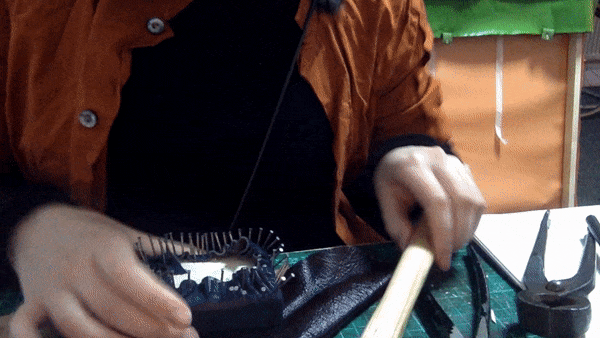
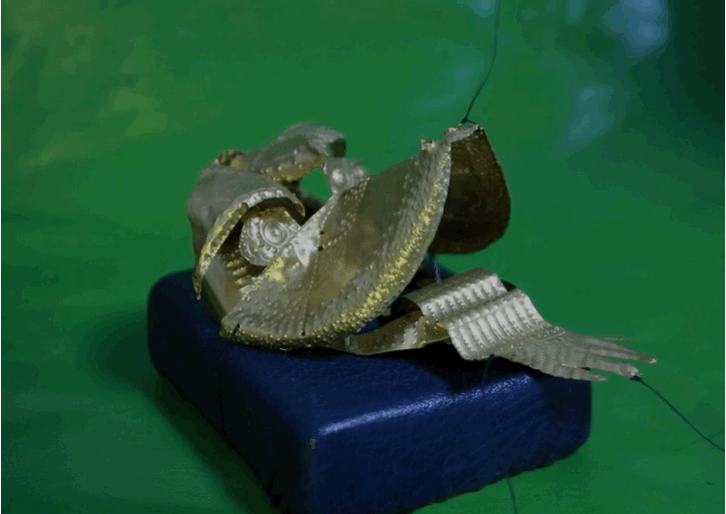


Make some noise and make a shiny enemy while youre at it.



Plinth Making


When I was considering exhibiting my work inside the tent I made, I decided to finalise the props that I had made in the past. I thought that it would be a good idea to attempt to make plinths for my UFO sculpture and my crocodile. perhaps it was because they were made of brass. they had a sort of royalty to them. I felt they needed to sit on some sort of royal plinth. what I had to hand was the same letter and some MDF. my time shoemaking taught me how to stretch leather found a wooden shape in order to form the leather to make it smooth. all you need to do this a shape that has curved edges to emphasise the smoothness of the technique. for me, I used off the edges of a small block of MDF no bigger than an inch thick. then using panel pins attached the leather roughly around the shape. One by one I attached more panel pins stretching the leather with every hammer blow. the movement of your pliers is really important with this technique. the twisting action you make allows for the creases to sit neatly against each other. then the leather smoothly fit around the shape of the wood.
I enjoyed this process but felt as though it was overkill for my props. What was really missing from this process was my interaction with the props. That's what made them interesting to me, not for them to be polished old school exhibiting this kind of way.









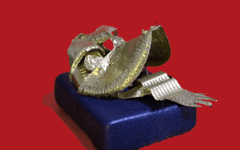
After some thought, the gold background that I created with the safety blankets over complicated the scene. It also seemed to not represent the character of the crocodile as intended. There needed to be another moving aspect that emphasised its nature.

Using a metal bowl to reflect a video for the scene to sit within. The flat bottom of the bowl makes for a different reflection. When cropped in a certain way, the shot looks less bowl-like and more like an iris.
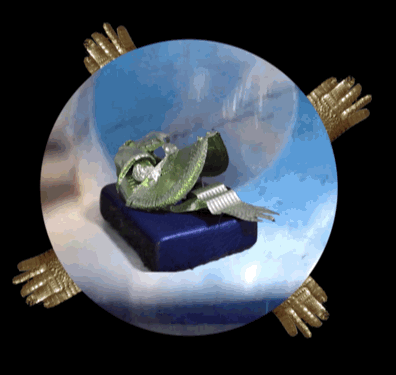

My canal boat had at this point been sitting on my fireplace for some time. Dehydrated and well sad. She had a flirtation with her new name ‘Molly Aidia’, after the steamboat that set sail in the Amazon to bring the opera to the masses in firtzcarldo’s mind. However, this name shake pipe dream had long drift away. She sat without an identity and without a trip on flowing water under her…. Hull.
My canal boat would soon venture beyond these 4 walls and to the stagnant and dull waters of Queen park’s own ‘Duck Pond’. Yes, you would be right in remembering that the other larger and considerably less weedy waters that sits right next door to Duck Island is in fact used for model boat sailing. However after reading the heroic lines from the KLF, I decided to pursue chaos instead.
There is a reed bed that sits around the edge of the duck pond, around a meter in diameter. These prevent the access of human to water. For good measure, I might add, as the contents of the water would be inaccurate to be described as water. Think more, sludge.
Without a motor little, Molly Aidia would float and not much else. To my surprisement I had had the foresight to attach a small door latch to the stern and attach a bright red cord. This helped considerably in its movability. However, Aidia without assistance would be the snail of the seas.

Notes from canal boat venture
-
Bring wheelies
-
Bring a way of pushing out the boat
-
Make sure of the quality of the phototage
Ideas for going forward
-
Make the shot where I would be dragging the boat through shallow water
-
With some close-ups of the boat in situ itself
-
Get a shot of the boat on my backpack
-
Attach rubber to the sides to stop bumping
-
Attach the same rubber to the sides of the skateboard
-
Bring a green screen
-
Rosshall park?
-
Me cleaning the boat

After writing my dissertation on functional discourse, I came to conclude that functional failure is the route to authentic practical being.
The duck pond incident
When we fail with our tools we embody the functions exertion and come alive in the realisation of us being the easiest thing to operate adaptively.
This has become a mantra of sorts. A source to dispel some of my anxieties and fears. If I channel the fear of failure into the source of authentic understanding, that I can understand my environment better if I seek failure, the fear fades.


Go pro setup and footage

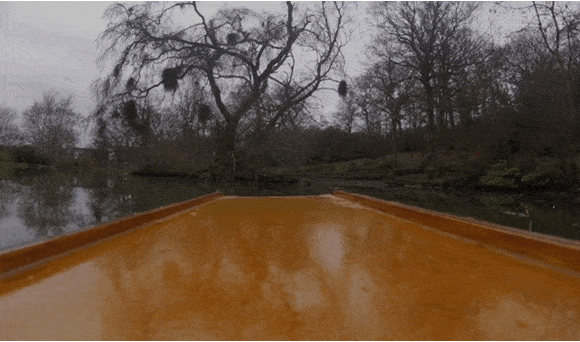
Small piece of rubber to reduce movement
Security thread!
Bungee cord


Frank was a ledgend, you know he was, he really was

Chaos and bizarreness, it all exists within a man pretending to be another and that man's name was Frank Sidebottom. There I was pondering about what it was that I Was going to do in the next stages of my project. I wanted to bring about the vibrancy that came with the light performances I saw from Laurie Anderson in her lectures. the differences I continuously seem to run away from the seriousness of what I'm trying to portray in my work. my heart didn't feel in the right place when I started to test the abilities of the open broadcasting software, the performances were stiff. I just didn't seem to be portraying the same authenticity as perhaps I used to be comfortable with. and then I remembered in My Time of Need all I need to do is what's the turn on one of Steve Srivleys work to understand the vibrancy that can come from real honest chaos.

Initially this late 80s early 90s creator hurt his hand conquering the music business. He had an Arsenal of tricks up his sleeve. individually drawing each cassette tape cover, making a book of his rejection letters from record labels and being one of the first people in the world to ever utilize the capabilities of vinyl records to be used as a dual purpose for video display. project after project and setback after setback Chris never stopped. it wasn't until a Halloween party where the character Frank Sidebottom was created. a paper mache head and normal acrylic paint a head that balances on top of his own. Slowly this character formed into a sort of pseudonym for the artist. if he wasn't seen as a one-man band Before Frank Sidebottom appeared there was no mistaking who was ruling the roost after. What's so fascinating about this musician is the authenticity in their performance. In an interview he's asked whether all of the setbacks he's had trying to pursue his music career, frustrated him. His answer made evident he wanted to pursue something honest and real and something that accentuated the joy he felt becoming the character.
Chris Siverly had left the building and Frank Sidebottom entered it. there was nothing that wasn't covered by this character. A monthly newsletter called comp documented the whereabouts and wondering of Frank Sidebottom himself through the eyes and the words of this character the love and attention to detail and mystery and backstory that goes into documents are wonderful and insightful. this isn't just of the run of the Mill characterisation of a persona. It's the history of an individual going through a transformation in their lives. meeting a point at which they have had so much rejection for being who they were, and coming out the other side with a huge wealth development creativity in something new. Frank Sidebottom South was a performer and excelled the previous attempts at making a musical career the artist had attempted. slowly Frank Sidebottom became a hit. documented in a wonderful film made by Steve Sullivan called being Frank, we learn about and the Downs of this man and his character.
It's one of the best ways I can see the pict moment culture and what we find funny and what we like to listen to can all be encapsulated in a man that was pretending not to be himself. the detail office World went beyond just Frank, there were backstories with other characters in a similar paper mache form. When a mistake happened in one performance that Frank Sidebottom was hosting in a pub and one of his props lost its head he gave a backstory and an explanation to why this character has lost his head.
A documentation of one of Frank's failures, whilst talking at a comedy show he mentions the time he introduced bross to fans at wembley arena.
text comes from 'being Frank' (52:43).
'did you know I did Wembley? I got booed by 55000 people. started off alright, you know. "hands up if you like Matt" yeah they all went "hands up if you like Luke'' yeahh they all went. "hands up if you've got beta max?" total silence when over the stadium'
The first introduction to Frank Sidebottom was his animated series. Stevily set out to make almost full feature film, in an animated stop-motion format he is claymation old school photography techniques props, models, anything that you can think of to make his world come to life. Lovingly crafted it's an insight to the detail of the work.
To give an example of the level of detail that was involved within his work, whilst in the production of his TV show made a series of frames shots of the camera. in these frames which were hand drawn small motifs existed alongside a cryptic collection of letters and shapes. For a very very long time nobody paid much attention to these inscriptions. until one day while sifting through rooms worth the artist, a friend found a book which contained similar symbols that matched the frame from his TV show. It took a world renowned codebreaker to decipher what he said in a couple of Seconds of footage. he just didn't care nobody else with ever see this detail he didn't predict that somebody would go to the lengths to try and find out what it meant is an artist because it meant something to him because it expanded his well just that little bit more characters Richard and the comedic factor of what he was doing funnier not other people but purely just to himself. This whole journey of exploring the boundaries of performance creating a whole universe is one that is so beautiful and Rich should be a shining sample of what we should aspire to do as artists. money was no question. explanation was not a problem. it just mattered to him. because it matters to him it mattered to us a hell of a lot.

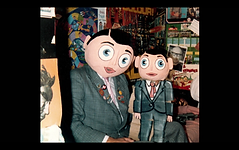



Fake Franks

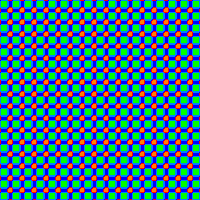




After my realisation of movement being the answer to install the action elements of the props I made, I was looking wistfully at my canal boat and thought about how long it keeps out of water.
It sits so still in this time, it's a little sad really. And so I gave in to what my heart wanted and made it a skateboard to sit on. The idea behind this was really to think more about scene movement. I wanted to slowly integrate the canal boat into the film and thought that filming it getting to the pond would ease this introduction.
Yes, I did think about making it a simple skateboard, but the crucial element of a boat on the water is that it tips from side to side. And hence the skateboard needed to give off the same illusion. I also want to use it as a bottom piece for the spaceship. Simulating the landing strip.
The making of...
I started to buy creating a template, about an inch larger in circumference than the boat, to give leeway for attachment purposes. I then found some reasonably priced wheels from a hardware shop. Making a higher point in the middle of the skateboard, I attached a wheel about ¾ of an inch higher than the others which were attached around the front and back of the board. The idea behind this was, that as the boat was rolling along the ground, the ship would tip from side to side on and off this higher wheel. With hindsight on my side, I would have used different wheels. All of the wheels I ended up using had 360 movability, this is a bad bad idea, as when pointing in different directions, the skateboard will capsize. I ended up using 6 wheels of different types to support the boat in this tipping endeavour!
Filming
I built this prop with a shot in mind, where I would drag along the canal boat on the street behind me. But due to the uneven terrain of the surrounding streets, I decided to rule out this possibility. I realised if I kept the string to support the movement of the skateboard/boat, then I could make the movement more dynamic. I started to dance with my canal boat in a little ceremony to wake up my poor neighbours below me. Suddenly more shots came to mind and excitement grew.
The boat became a rather large instrument to have to lie around the flat. In fact, it became such a burden that I eventually decided to keep it stalled in the rafters of the flat. And hiked it up using this bike winch that sits unused for the most part. This made its way into my film and a scene was born!








Skateboard adventure
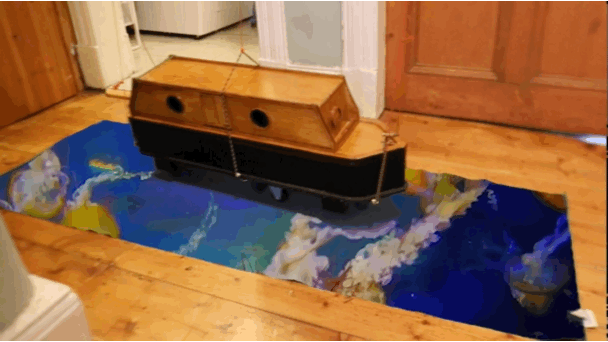
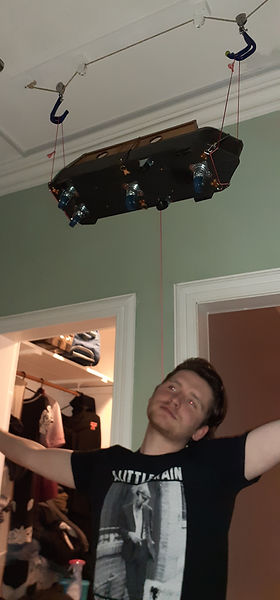

Sceptical joy, what's so scary about happy work: Pipilotti Rist
When Pipilotti Rist smashed car windows with a smile on her face, how could you not expect the world to change. The utter silliness of the universe we are introduced to an alien look at performative joy. “Ever Is Over All” encapsulates what the artist values, it draws you into the anarchy of a single event. It does so without being overly proud of itself, if that makes any sense. Its the comedic aspect and timing of the work that accentuates this. It's serious business done proper and by proper I mean fun.
The Swiss video artist wants her groundbreaking work to be like women’s handbags, with “room in them for everything.”[1]
What makes her work so engaging is the acceptance of a certain level of chaos that she promotes.
Sip my world, was on of the artist’s most recent exhibiting works, where by serval rooms display installations, and many projections of her latest video works. One of the most engaging aspects of the set up is the display of the work promotes the accessibility to the work. Beds are there for visitors to lay down and view the world being projected on the ceiling. This really made me think about what accentuates my own values of the work that I’m making. Do I want to give people the option to ‘soak’ into the work, or do I want the chaos of the work to particularly limit this, to accentuate the momentum? The representation of the work is keyed in this over saturated hyper reality mode. Its fantasy and illusionary and worlderfully curious. Everything feels impulsuive and some video installations are focused in on moments of pure curiosity. Hyper Zoomed in footage of plant life cropped in ellipses that are projected moving along a wall frame this feeling of childlike wonder.
In Rist’s 2007 show Gravity be my friend[2] she plays on this amalgamation of scale and wonder. Some interventions in the space are intimate and unique, like the broken floorboard image. Others are large scale and becoming within the gallery space. Das Zimmer (The Room) plays directly with the scale experienced by the visitor, by gifting them an oversized sofa to sit on whilst viewing another single screen work. This comedic factor in the work addresses several aspects of position and composition and challenge the eye to accommodate this new world that the work belongs within.
David Byrne and the Talking heads tour documented in the most legendary gig of all time, essentate chaos of his music theory, by never ceasing to stop moving. I listen to it as I am writing this in fact. I feel impulsive and have a boogie fever. The movement of the performers accentuates the character of the music. It produces an output for where your body should belong within. Just like the forced perspective of Rist’s installation does.
These forms of essentating joy though what is experienced in these installations is something I want to tackle in the next stages of the work.
[1]https://www.newyorker.com/magazine/2020/09/14/pipilotti-rists-hedonistic-expansion-of-video-art
[2] https://www.magasin3.com/en/exhibition/pipilotti-rist-gravity-be-my-friend/





New waves in my Music Venture
Sound is a function of time, articulating time and describing our surroundings at a level of subtlety that increases environmental awareness and the skills associated with attention, should we care to exercise our familiarity with the process on a regular basis. All of these observations are germane to the use of sound as a medium, yet they have the quality of a mystery to those who privilege sight and the word. Common sense and the prevailing view both insist that the world is a large space occupied by objects, all possessing varying degrees of value, magnitude and mobility, whereas sound is imprecise and ambiguous.
-
David toop ‘The art of noise’!
Making music for my sound track has had its difficulty to say the least. I have no idea where to start with explaining what journey I’ve been on during this plight!
My own music theory
During lockdown I picked up my old faithful trumpet, and started to get to grips with its tunnels of sound! Not knowing how to read music, I started by finding notes on the trumpet and started to form a language that I could understand for replcaing the nosies I thought sounded alright. These consisted of drawings of buttons and inscriptions of initiations of mouth movements. Slowly I have made a new language for myself to follow. One that has kept me in good sted!
I use this same language today to remember songs and riff for the trumpet. The latest venture in my musical journey is following scales using arpeggios and making music that fits in with each scale. I then change the scale I use within each ‘riff’ section, this allows me to not settle on one collection of notes. Doing this allows me not to become complacant with one type of tone. I still no idea what I’m doing, but I love the idea that to other ears it might sound palatable!
First I looked at the arpeggios in each key and recorded 4 bars of each key. They work well together because of what key follows next. I go from Eb to c(m) to C yo e(m). I then try to follow the keys with a unique riff over this recording. I then shifted the 4 keys to sets that would harmonise in some way with the sequence previously. So Eb suits g(m), c(m) suits Ab and so on…
Tascam recordings.
Using my past experience with the online synthetsiser, ‘blokdust’ I booked out a better recording device from the TSD service. The Tascam recorder was brilliant for allow me to get a better quality of sound for my singing and trumpet/ accordion playing.
My setup allowed me to record and edit live my recordings, using the Tascam recorder, linked up to an 8 track I borrowed and an amp, I was able to feed this in live to the online program. This enabled my recordings to change in pitch and convolution and general additions. I enjoyed this process throurolly!




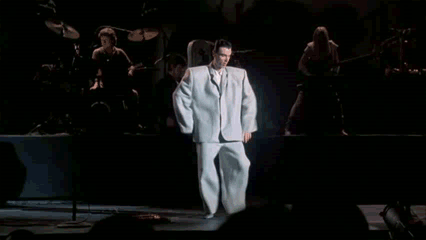
When David Byrne was asked why he wore a big suit, he replied:
'I wanted my head to appear smaller, and the easiest way to do that was to make my body bigger. Because music is very psychical and often the body understands it before the head.'
And so I decided to get into the habit of wearing my space uniform when making music.

Arpeggio Trumpet Riff
Play with sound!
This is how I write down my musical notation, each symbol has a meaning usually describing the feel or intonation of each note. Making this little language is half the fun when playing, takes some of the pain caused by embarrassment that after all these years I still cannot read music!


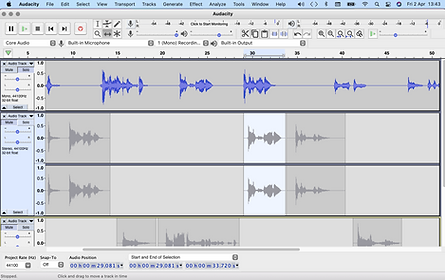

Round 2 // Revised Test of melody with scales
Testing out recording with Tascam whilst filming
Stick on the audio for the film below, to get an idea of the difference in sound qaulity
Wauh Wauhh - Spagehetti Westerns and Finalsing my sound track
The opening passages of any movie set the notion for the rest of the epilogue. Most successfully this is achieved through a score. Spaghetti westerns are the core of this philosophy. The harmony and chaos felt in the opening lines of the harmonica are unusually stirring and practically tell the audience that this is no normal western. Instead of melancholic dulcet tones of the harmonica, we meet uneasy wind that lingers in an atmospheric reverb wind. It was this that spurred on the choice of the instruments and the amount of reverb used in this piece!

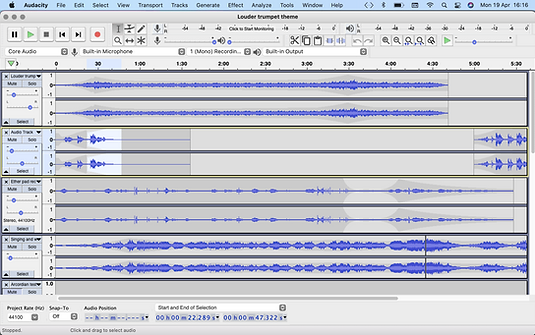

Instruments used in sound track crafting!




Toy Arcoridan
Tiny Trumpet
Ether Pad
Also: Whistling + Some (very) autotuned singing
Understanding the cliff and valleys of the tone of the music piece I was working on. To the left is documentation of the suspense and drama throughout the music. I did this to perhaps allow for the work to be rewritten to fit the momentum of the film. Something I will come back to later.


Thoughts of Authenticity and Preservation
Not long ago, I watched a film called ‘Perfume’. The sort follows a man who lives with a heightened sense of smell, one that defies the abilities of any living person. He goes obsessed by the smell of certain individuals and pursues a quest to encapsulate the smell of a human. His methods for doing so, involve the humans own demise. Hence the smell of the individuals he pursues becomes the only embodiment of what he saw as their spirit.
The notion of preservation has been playing on my mind and it seems the ‘spirited man’ Van Niestats mind also, who after conducting an experiment analysing a piece of comical writing concluded to him self and then the world that what ever art must be has to be the preservation of human spirit in some form or another. This has stuck with me as I often write and dissever my own authentic nature and that of functional authenticity. Perhaps thats why I make my research more holistically complied, as it is a documentation of the influences that go into my own understanding of the self and beyond. Everything matters in this great mix of decision making and action.
The authenticity of this representation then matters. It matters because if it is going to represent or transpire through the screen, it must do so in the same manner. To be honest I haven’t been thinking about this. I’ve been more preoccupied by my own authenticity in communicating with myself as a sort of selfish task. Perhaps in the fallacy of ‘Perfume’ the reason the individuals had to die in order for the preservation to be perfect is because it would be wrong for there to live in the world two perfect embodiments of an individual’s character.
‘The transition of feeling the artist had experienced’ -Tolstoy
Fitzcarraldo is a film that follows a young man obsessed with the idea of bringing his beloved opera to the Amazon. Strapped for cash he buys a boat in the hope to entertain the masses along the backdrop of the amazon. As he pursues his dream, we see the other obsessions of his life. Inventing ice machines, railway lines, theme parks we pass these failed project as the current project moves onward. The film lives in the wake of this chaos. The destruction and death he leaves behind is immense. This man is plagued by his dreams, too intense to match the cruelty of reality.
The project take Friztcarldo along the amazon where he takes a wrong turning and ends up stuck hundreds of miles deep in jungle. Meeting the tribes of people that live by he has a plan for escape. He plans to clear a pathway over a mountain that leads to a river that flows in the right direction for home. Once over he plans on exploiting the locals to harvest Rubber, to make enough money to feed his ultimate dream. The plight to pull a boat over a mountain becomes too immense. Ultimately leading to another series of unfortunate events.
We watch as this man becomes madden by the chaos of the unyielding jungle. There is a synergy between this goal and the reality of the land. The balance is never in his failure and ultimately disaster ensues. My work has been heavily influenced by this film. Never before have the ideas of failure been so beautifully displayed on tape. What has become even more eye-opening to me however is the documentary ‘A burden of Dreams’. That documented all the failures of filming a film about failure.
The documentary leads up to the moment the boat moves. The monument for the film lies in this action. Life in-acts art, Herzog becomes the person whose lives are twisted by his dream. As soon as the first attempt to get the boat over the hill is underway, the belief from the crew and actors diminishes and fades. The film is placed in jeopardy due to this doubt. However, doubt lives in Herzog’s mind also. After reflecting on the 3 boats, what can only be described as a small civil war, plane crashes, racism and the loss of several peoples lives he begins to question his profession. ‘Nobody will convince me to be happy about this movie, even if I do somehow complete it’
Nearing the end of his time in the jungle, it had all told been approximately 3 ½ years, Herzog reflected on how his opinion of the landscape had changed. The fear and fireside that he speaks with is overwhelming and slightly alien to me.


Fitzcarraldo and Burden of Dreams, a film about a film


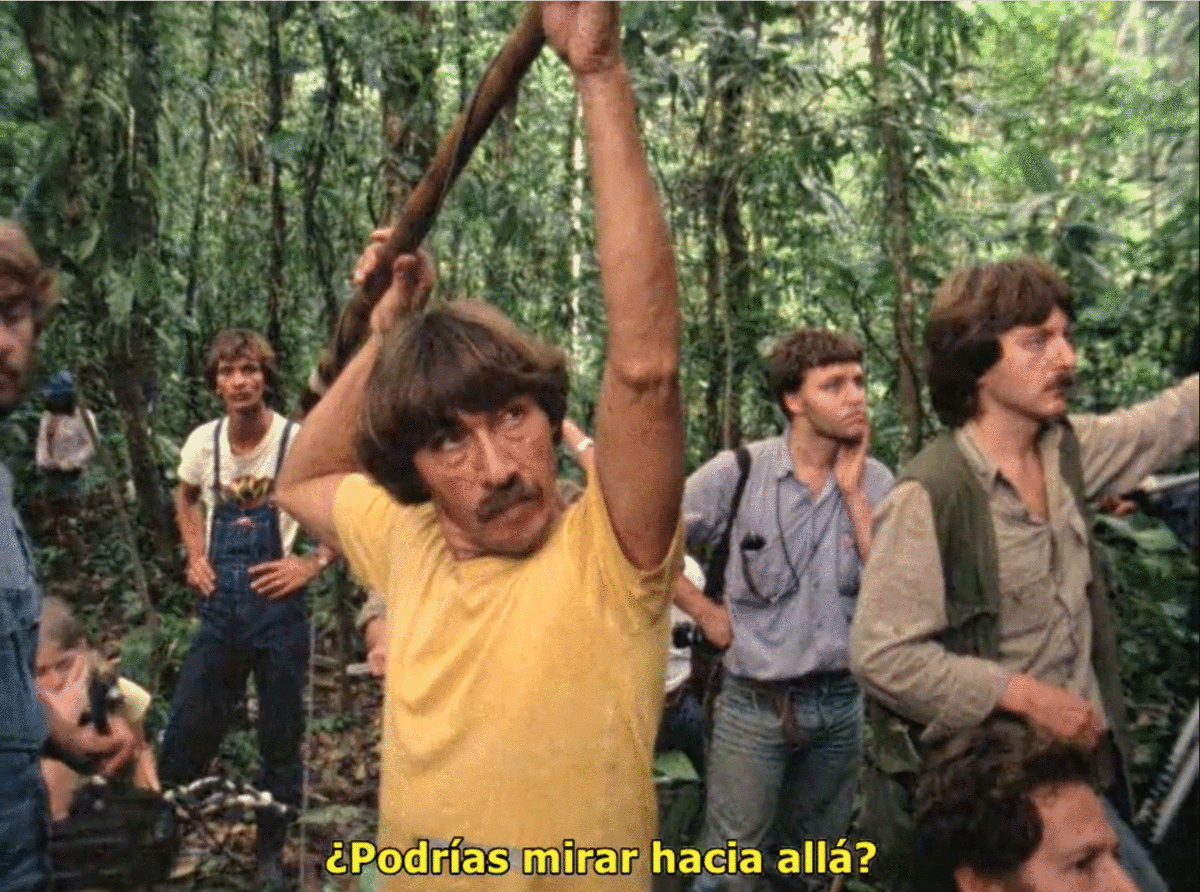
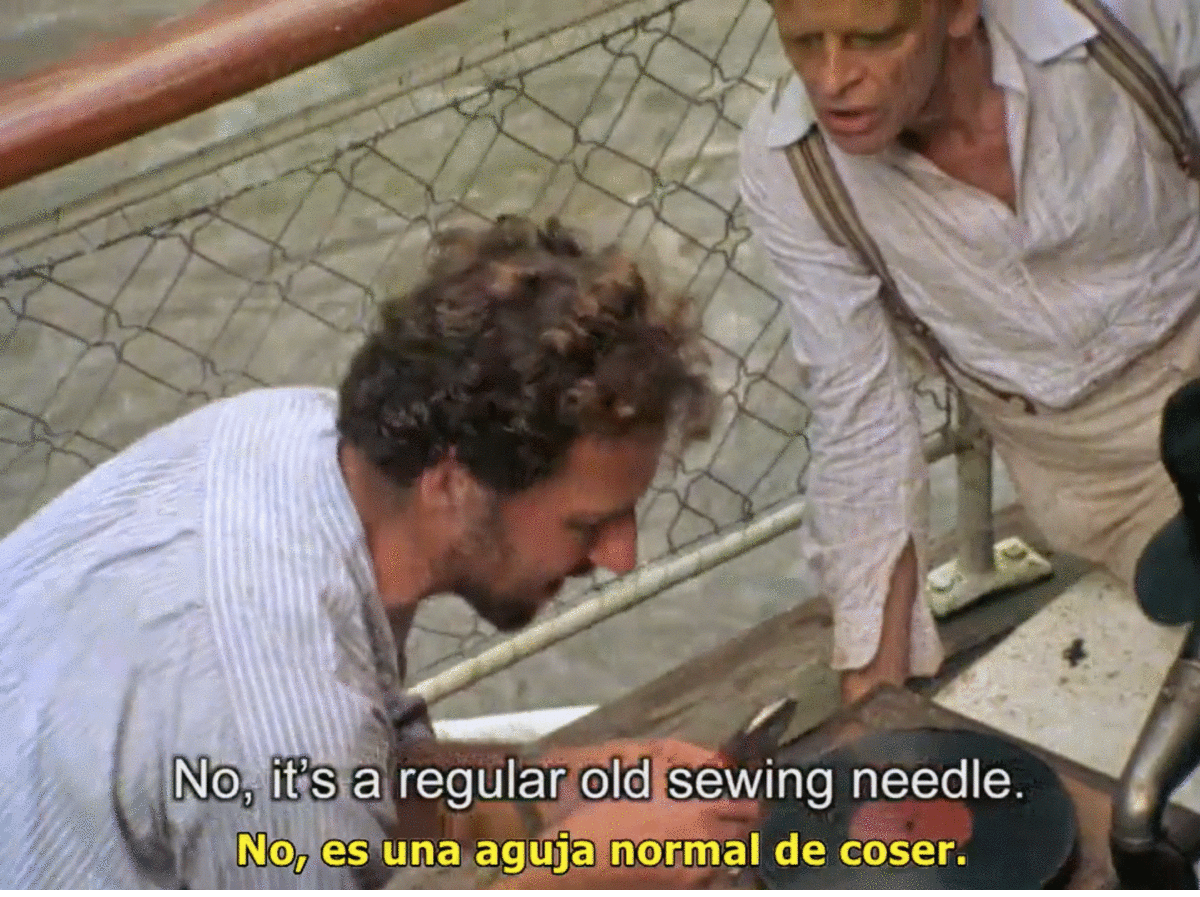
‘We are challenging nature itself and it hits back… And we have to accept it is much stronger than we are. Nature here is vile and basic, instead of erotica in these forests I see fornication and asphyxiation and choking and fighting for survival and growing and just rotting away
Off course there is a lot of misery, and it is the same misery that is all around us. The trees here are misery and the birds are in misery. They don’t sing, they just screech in pain.
The only harmony here is of overwhelming and collective murder. Even the stars in the sky look a mess. There is no harmony in the universe. We have to get acquainted with this idea that there is no real harmony.’ [1:21:05- 1:24:16]
We can gain the sense of a man on the edge of something. He has become intertwined with his fears and desires to the point that causes his outlook on the world to be warped and exist in the extreme. Nothing is placid. Nothing holds serenity for him; he can’t see the harmony of the world anymore. The chaos that filming a dream has caused in his life is so overwhelming. The director is almost resentful of the chaos that he has inflicted onto the world. The consequences of his actions to pursue his dream fades into the misery that he sees in the forest. It makes for a beautiful and huating reflection of an individual's plight to succeed. The film no longer becomes about an idea but an obsessive process.
‘There are not just my dreams, my belief is that all these dreams are yours as well. And the only difference between me and you is that I can articulate them. And thats what the arts is all about its as simple as that’ [1:31:00-1:32:48]
I found this idea difficult to face, that articulation of dreams is only that which is held by the artist or creator themselves. Something that has sped my own filming along. I love the escapism of watching worlds being formed and created in sci fi movies. We are taken along for the ride, for the adventure. What we see are the peaks and valleys of an individual through hardship and reward. Only on a passive level do we experience this. Do we understand the full depth of the challenge. To pursue is to function with this difficulty. To articulate our bodies around the challenge. We sit still and observe the fight to climb the mountain, we see the movement on the thought but don't function as the protagonist does through viewing. This barrier of experience is so sadly contained and held hostage by the ideas articulated by others. We feel the same level of accomplishment as the protagonist of a movie and the more we view the more this need for us to also accomplish the failures and the rewards as they do. This is what I wanted to achieve in the making of this film. To put on record the failure of me as a maker. It is my adventure to be a compilation of small failures. One leading to the next. This way I am immersed in the sensation of the adventure. This way I hope that others can too. My sci-fi movie is less of a film than a documentation of making a film. Its contents are props that have held this functioning ability to emphasize the functional failures of escapism. Polished? No! Authentic? I hope so!
As a response to Friztcarldo//Moving mountains - Making a winch







David Sherry
Thursday 25th Feb
Notes from Talk
-Recognise the hypocrisy of yourself and others
-Performance rants / seriousness how serious the serious man could possible get!
-why don’t you have a character for your own performances?
-‘I accentuate my own!’
-Processing contemporary practices
-Operating systems within airplane
-There is a sense of control/ using humour to tend to control
-Challenging controls and tempting fait and hypocrisy
-Post my hand in a box performance
- not make it seem like a prank
-
Making an action that gives you a distance from ordinariness





Celebration of Failure (Delivery Man), 2018.
[Written by David Sherry, sourced from: http://www.dave-sherry.com/Itinerary.html]
'Three-day performance for Look Again, Aberdeen.
In this performance I walk through the city as a delivery man with an over loaded trolley (pallet) pulling the trolley through town, as if delivering boxes.
The boxes are piled too high and keep falling off. People come up and point out my stacking mistake. Telling me: ‘That’s going to fall-off mate’.
I perform the act and action of delivering boxes that fall onto the pavement, continually. I don’t have to be anywhere at any time.
I act out the role of a delivery man, honing my expressions.
Wearing a delivery man outfit with boots and a Hi-Vis jacket.
I have a google map of Scotland sticking out of my pocket, I consult the map of Scotland throughout the day, for no reason.
Placing the boxes back onto the trolley and moving on.
Pulling the trolley, a little further. Then the boxes fall off and I stop and look shocked again, how did that happen!
Developing a public character, a man with boxes to deliver, an honest man doing an honest day’s work. With a serious face for an idiotic philosophy.
Delivering to a non-specific address. Going earnestly no where, round and round the city day after day.
At one point I carried some boxes by hand to a point in the street. I seen another delivery man do this, so I know it is an authentic gesture. I cross roads and boxes fall and bus drivers beep and try to run over me.
The outline for the work is to celebrate this failure, my objective as a performer is to work at the failing situation produced with the trolley, pallet and boxes. To earnestly deliver boxes to a non-address. Repacking them badly on top of each other. Balancing them on the edge of each other so they will fall off again.
At points the Delivery Man chats to the public, sitting down on the boxes - if the opportunity arises. Every now and then I tell someone that it is an art work, and someone says ‘we thought you were up to something, we were looking at you - thinking, is he for real?’.
People often help the Delivery Man as he goes on and the boxes fall off and spill and it becomes a celebration of failure. Many people look out of their windows transfixed by the bad workmanship. The entire scene, developing a work-like mess in the street.
The Hi-Vis outfit was a revelation like a badge of honour, an award. I felt like I had been initiated into some kind of worker’s club. I felt purposeful walking around in my worker’s outfit. At one point the police came up and told me they had been watching me on CCTV, and why was I heading towards the motorway?
‘Where are you going to sir?’ they said.
‘Over there’ I said
‘Whats the address?’ they said
‘I’m not really going anywhere, its an artwork’ I said
‘Where were you born?’ They said
That conversation with the police was a highlight.'



Whilst editing my movie realised the shots were becoming less and less engaging to me. I think this was down to this being the first time throughout the time it GSA that my work was being presented solely in one format. It became daunting to think that my work would only have been seen in the film. Every so often when editing I find myself stopping to take a break. I needed the distance from the representation of an idea in a single physical format. An idea came to mind , a way of distancing myself from the very thing that I was tackling.
When I became overwhelmed from making during my A-levels I picked up a camera and when I became overwhelmed by taking photographs I would start making. And when I became overwhelmed by everything I would attempt to do this one piece of work that I never quite got right.
in this piece of work to shoot footage through a long piece of PVC piping a smooth edges side of the tunnel allowed for anything the pipe pointed at converted images of bursting colour. The fluorescent lights in the garage at home made this colour intensity even more vivid in my movie The toasters together. Shooting through a very long about 3 m long piece of piping had its challenges. But the benefits are loud for a spectacular understanding of the world around me. the contents in my world when more than Arms reach away, I could never quite figure out where the piping was pointing. This is what made the piece of work so engaging to do. It made me think about my environment, what was really in front of me ? am I really seeing the true nature of things staying the distance there's me the content of my Reality makes me see something new and different and exciting? This is what was engaging about doing this piece of work almost meditative.
I wanted to capture this feeling of distance and closeness in my movie. this had to be done physically through an online piece of software. I wanted it to seem unrecognisable and yet I wanted it also to have a sense of familiarity. I initially thought I needed to use a large-scale tunnel to get this effect. but later realised that I would need nothing more than a tin can. Initially, I had an image in my mind of where a large plant pot would spin by the use of a motor.

Playing with the lense, using a tin can
later found this overly complicated. instead settled for a tin can holes in its sides. Instead of moving the tin can itself all I needed to do to give the effect of it turning was to move the light source that shone through the holes in the side of the tin can. the rigid edges of the tin can and the light bouncing off of them allowed for this effect movement. I enjoyed the playful nature spinning several lights around the tin can frantically making sure not to knock the can self. there was a sort of forced Serenity in the action. It reminded me of the meditative state of making the PVC piping video. I shut the tin can against a green screen. green light bounced off inside can be seen in the original footage. is proved to be really helpful later down the line. when I found changing the colour of the tin can, was really simple. I did this a few times changing the colour to orange and red and blue stitching knees frames together and the scene came to life. like a little disco ball. when the tin can is cropped so all we see is the tin can itself a black background it looks almost Iris like. however when overlaid when I manipulate the opacity of the scene, another effect takes place. it's almost as so the scene is introducing the viewer to the camera. I really enjoyed this perspective. the idea that I'm showcasing Life behind the hardware that I'm using. as though it has a conscience.

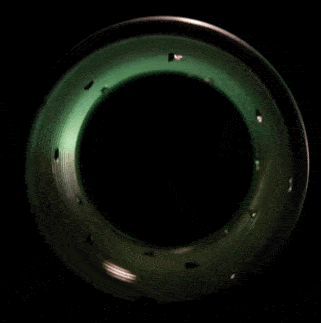
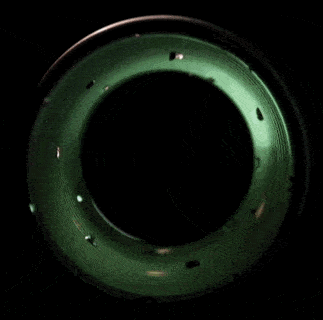
Other portals using my trumpet
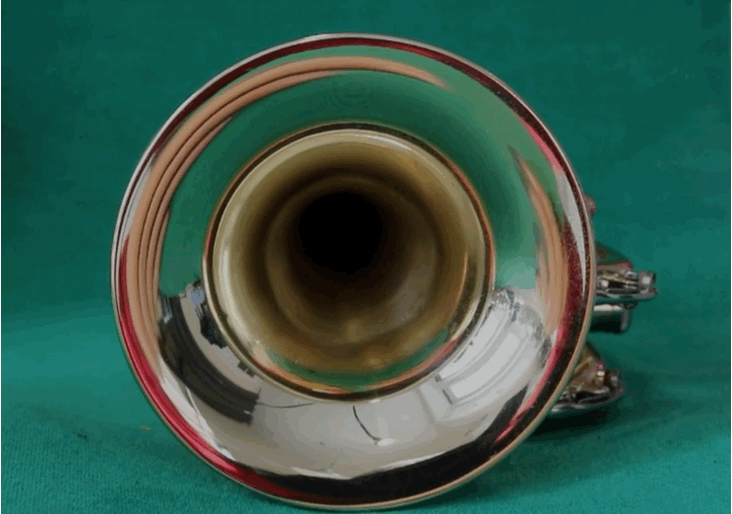
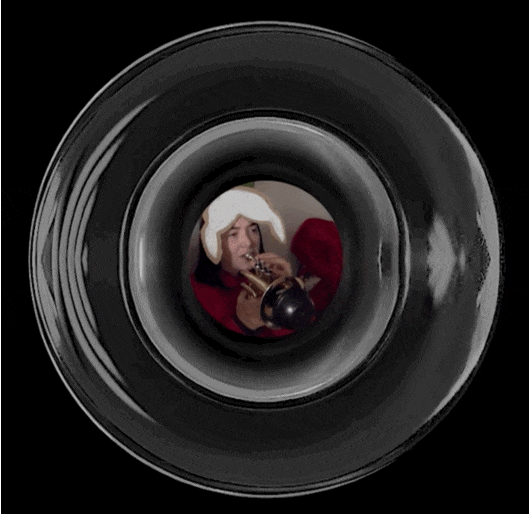
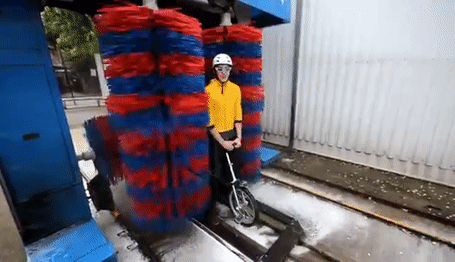




Boat wash- More portals and filming...
The same day that I shot footage the boat the Duck Pond, brought back the boat set find it rather dirty. it had been sitting on my shelf for a rather long time, I would have thought that the duck pond water would wash away the dusty sins from neglect. however this wasn't the case, so I decided to wash my canal boat. I wanted to film this in action because I wanted to the chaos that happened stations I chose. to show the authentic side of making film in such a bizarre manner.
this was one of the first times I had shot footage inside the controlled environment of the home. normally I would rely on the light from a sunny day. I need the shot would take a considerable amount of time. I'm with this him the Changing Light throughout the day. so I decided to replicate the sun light so I could shoot for a few hours without the shot changing too much in temperature. being in the bathroom I had the shower curtain as a really good tool for diffusing light. luckily shower curtain sits exactly were my window is. this meant I could put a light behind my shower curtain, and this would replicate a stable form of light.
other decisions I made included placing a light find the door that sometimes you see in the shot. the light source I used for this came from a sad lamp, used for therapy purposes. it's an LED light that allows you to change the temperature and time but it stays on for. it has a large surface area small piece diffusing glass over the top of it, this allows no one point of the s a d lamp to be too overpowering to the eye. placing it behind the door gave a sense that there was another room that wasn't quite inshot. when I used a close-up shot my face or my hands cleaning the boat with soap, I directed this light closer to what would be most in Focus. this allowed for a Higher quality of footage. I enjoyed this process, and would later replicate the same methods of lighting and shooting for other indoor scenes.
Before shooting the scene, I had made a prop out of old bits of wood playing around my studio space in the east end. in my head wanted to create a prop that had multiple uses. I wanted a large-scale version the portals you see in the canal boat itself. to do this I used a bit of hard cardboard I salvaged from the recycling, and Billy cut out these veneer pieces to fit around the circle cut-out. I then glued these using a wood glue after lightly sanding the back of these pieces, even lightly varnish layer of the prop to match a little closer to the colour of the canal boat. this allowed me to again portray the eye of the camera itself, and give the veiwer of the work a forced context to belong within.
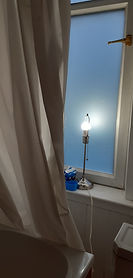


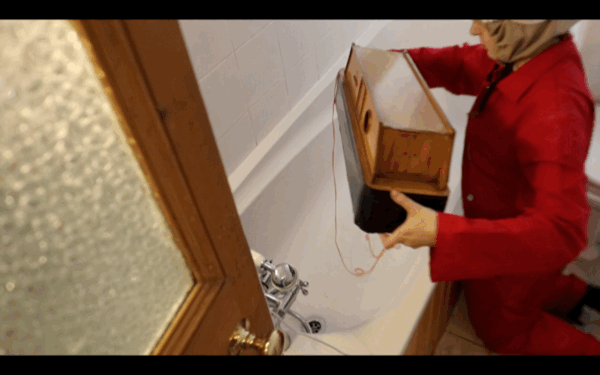
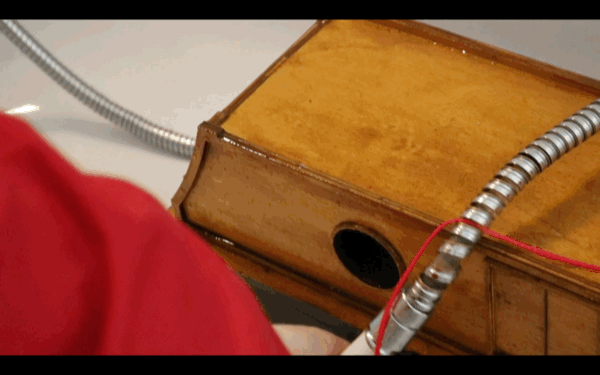
Jonas Mekas





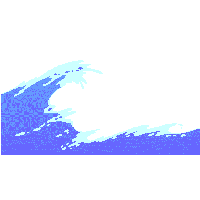

Bring in live performance to my practice, how best to conduct?
A Quick Reference to:

'Art by Telephone'
- Richard Hamilton, Wolf Vostell, Robert Smithson and others
'Occurring at a time when the art world was moving away from minimalism and in a more conceptual direction, Art by Telephone asked artists from the United States and Europe to communicate their ideas for artworks over the telephone to MCA curator David H. Katzive. MCA staff then executed the works based on the artists' oral instructions, avoiding all blueprints and written plans. After six weeks, all of the works exhibited in Art by Telephone were either destroyed or disposed of by the museum.'
-https://mcachicago.org/Exhibitions/1969/Art-By-Telephone 1969 MCA
Revilations and inspirations - Laurie Anderson Lecture and OBS
After a day of battling with spooky pitches, I came home to the most delightful noise of all. Laurie Anderson talking about whatever she wanted in one of the most engaging lectures I had ever witnessed.
The Forest Laurie Anderson’s Second Norton Lecture took countless of silent viewers on an interactive journey through her thoughts on music and experience within the battle it poses. This was no lecture, it was more of visual collage within music and non physical space.
How do you capture the essence of a moving image within sound? When recording music, I found the main battle persisted living within these two worlds. As soon as I picked up an instrument it felt ill genuine to the moving image. As soon as I picked up a camera, shots felt ingenuine to the music.
Ultimately there could be no more helpful task than to staddle these two worlds. Crucially it has made me contemplate what it is that I am trying to portray. Without being definitive about what it is I am trying to say in all this work, they will never align.
What makes Laurie Anderson’s work so genuine then? What was it that made this lecture so engaging? It was the freedom of the individual at the very moment. She had free reign over what to show next during the broadcast. It wasn’t live no, but the action of her operating the scene selection made her talkative nature give rhythm and flow to her content.
It made me rethink my editing technique. Why was I pushing for something so stringent and tight, when the plight of the film was to express the plight itself of forming this universe?
Curious about how I could translate this technique, I searched the internet for a free broadcasting program that could enable this freedom. This is where OBS comes in. The ‘Open Broadcasting Software’ allows you to interact with platforms that support live broadcasting such as twitch. Curically it allows you to pre-upload videos and document them as ‘Scenes’, have live inputs from recording hardware and use your keyboard as a control to switch between these.
The freedom this presented meant for a new way for me to be able to ‘live edit’ and record over. A one man band. Emma's Space show… I could get carried away.
My plan?
To create discrete scenes in separate files, to be uploaded to the site. Adorn a space outfit appropriate for the occasion. Create a series of tracks that can be over layed and record some sound live, such as my trumpet (purely for comic affect). And combine these in a live one man show. A crucial part of for this live viewing to be in part documenting me attempting to do the one man band gig.





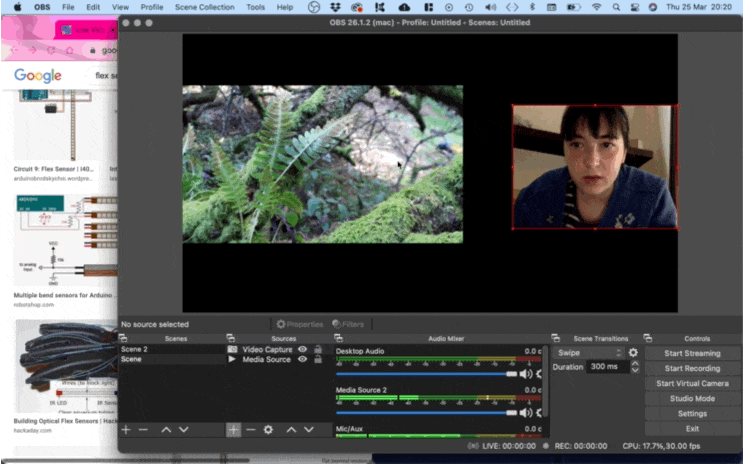
Testing out the open broadcasting software, I realised that transitioning between preloaded scenes is pretty breezy. In fact, compositionally these scenes can be preecided before they are used. Also, a nifty feature on the programme is the option to add a live input video feed. Here I use my webcam to do this, but it's my understanding that I could hook up a DSLR to my computer and have that as one of the inputs. I think I will come back to this method of editing at a later date. I want to understand better conductive performative works, to expand the scope of how I could use this as an interface for a more authentic immediacy to belong within the works.

Drum Dance & Smoke Rings Laurie Anderson
A quick reference to her conductive dance moves! Thinking about performative natures of editing work live, and the links to this action simulating the job of a conductor.
Sourced from : https://www.youtube.com/watch?v=6mRq1xgKykM

[CONTACTVEL MET FOTO’S VAN PERFORMANCE ‘WALL/FLOOR POSITIONS’]
BRUCE NAUMAN

Reminded me of:
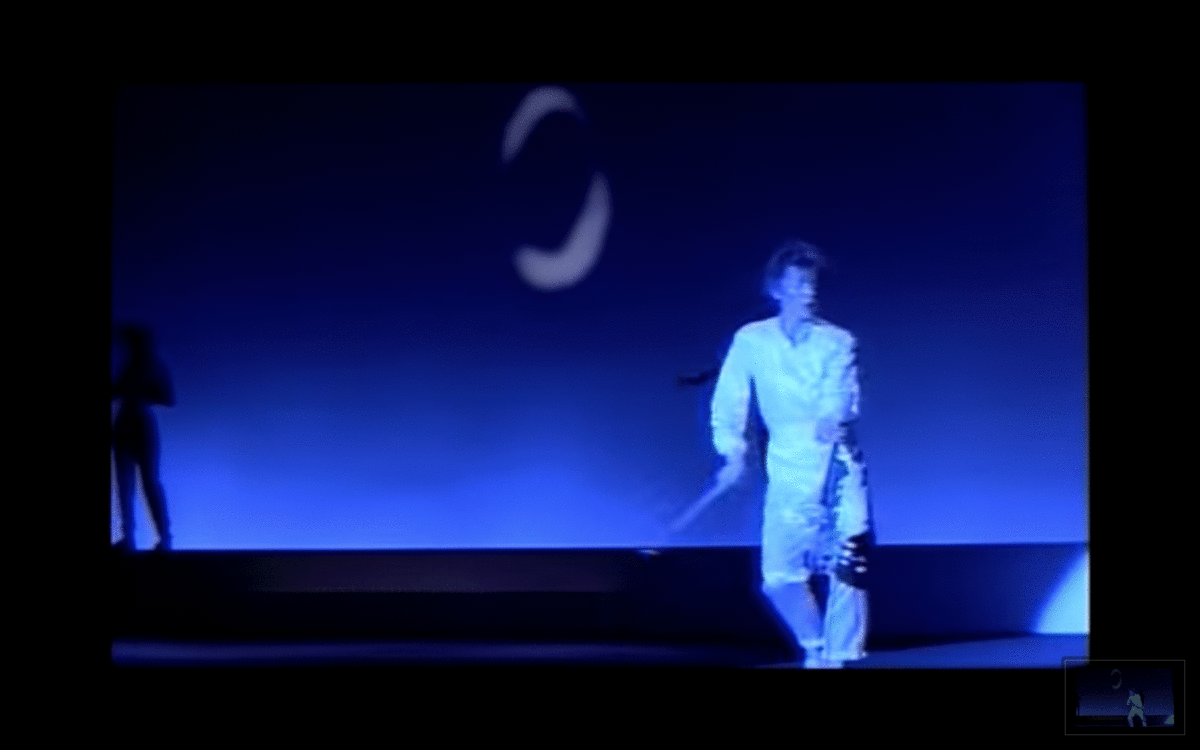

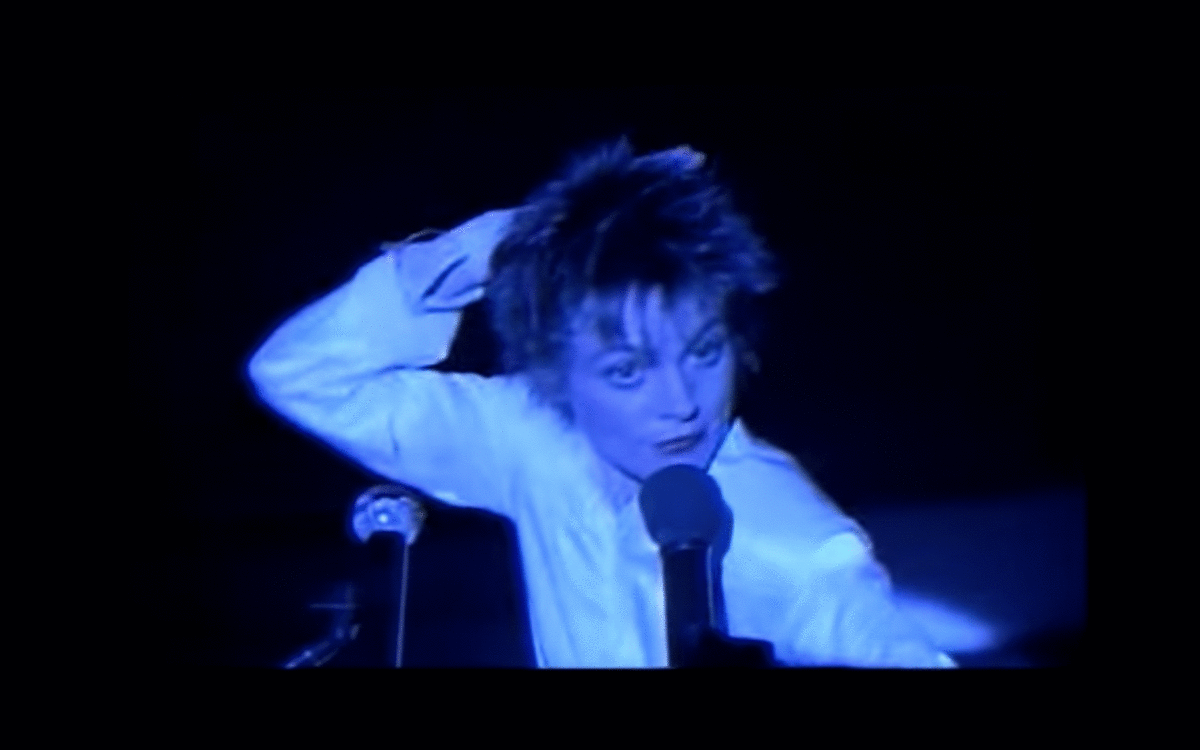
Note animation


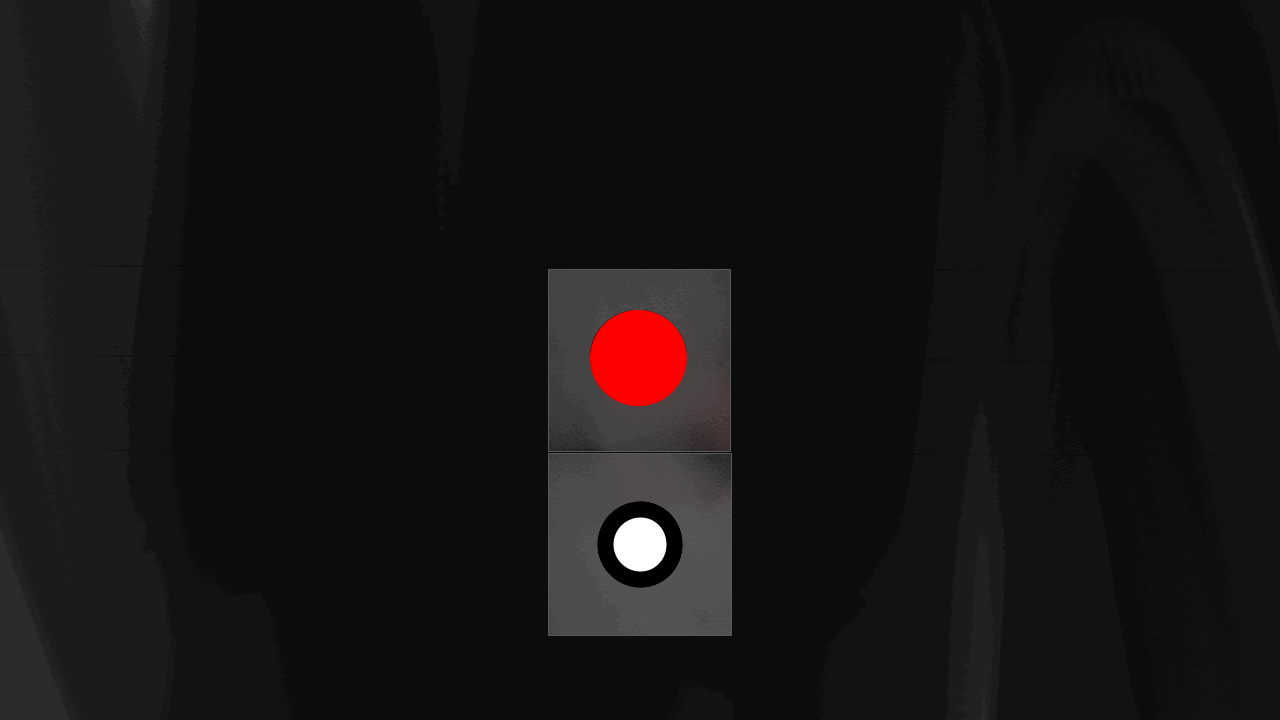
Another excert from David Sherry's Complitation of performaces which came to mind after the lecture
[Sourced from: http://www.dave-sherry.com/Itinerary.html]
Living the dream after death, 2010.
'While doing a performance in Basel I met this woman who shared a studio complex withSteven Parrino in New York. She told me all about him and it was fascinating to hear her story about what kind of person he was, his life and success. ‘He never made any art unless he had a show somewhere’ she said. She told me about his death and how everything blew up for his work, how he became really successful after he died. And how it doesn’t always work this way. I began to look more at his work, and think about his life and posthumous success. I liked his paintings and visual instillations of his work. I came upon this idea of making a large painting to sit-in and to be part of, with my hands and legs and head poking out of the body of the painting, for a performance at GAK Bremen. I asked for a large black canvas to be made, by the gallery. Luckily they liked the idea and agreed to make the canvas which was 5 meters by 3 meters. When I got to Bremen and seen the pre made canvas painted black, it was amazing. It was huge and brilliantly painted black, double stretchered, it was a super canvas. I remember thinking it was such a shame to mess it up. I cut the paintings wooden stretcher in half so it folded onto the ground and then I cut holes in the body of the canvas for my arms, legs and head to stick out, so I could sit in the painting on the floor leaning against a white wall. I sat poking through the canvas for two hours on the opening night. I did not respond to anyone. I just sat there really getting into painting.'
Laurie Anderson Lecture 3 Notes write-up

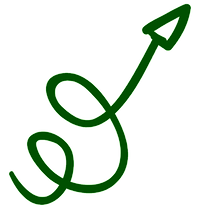

Waking life

Waking Life Is One of Those movies that keeps bringing me back again and again. the story follows the discovery of he finds himself to be in a dream. trying to figure out what was going on the character meet lots of it people along the way, they all have their own Theory on life, they all have their own Theory on dreams and on death. as the story progresses we find the character more enlightened as to the fact that he is in fact dreaming. his world collage what ended up being different artists work. the film was originally filmed quite a basic camera, scenes with a given two different artists who used a program to draw over each individual frame of the original footage. the effect is something incredibly unique to Richard Linklater's work. the film does something that's really interesting, instead of answering all of these questions that we have about the world, all of the why question that ponders, It just gives more questions. it poses these questions to us the audience as we try and decipher what the hell is going on during the film. it reminds me so much of the Laurie Anderson Lectures. the ideas that are really the most interesting things depicted in some of the most boring formats. lecture halls I'm not thrilling places to always be. the content of life's itself condensed understanding of many different series and writers. you could easily become overwhelmed with words. what does the film do is so exciting is 2 these words that normally don't exist outside of the old-fashioned formats preserved them and allowed them to live through the aid of beautiful and haunting imagery.
One aspect of the film that I particularly enjoyed is their imagery performers the original score to the film actually recording the music themselves. they become another character but follows you along with the storyline. in a lot of films that I enjoy or in a lot of things I find myself tap to it's this inclusion of dick and ideas fusion that makes the fiction richer. something Frank Sidebottom did brilliantly.
The world of 'Waking Life' is wealthy whether it's character (or rather Stanger) development or musical attributes. as there are no boundaries what can happen in Any Given situation that the protagonist is within, quite often the characters are absurd and sometimes terrifying the times disturbing. an angry man in one scene screams into a microphone with speakers coming out of his car. he grows redder in the face and his body as the saying goes on and as he becomes angrier and angrier. it's this visual translation of the text that creates a really interesting engaging work.
I've tried my hand at animation before. using free software called sketchbook I've been able to make simple framed animation. working with just 3 layers of possibility, the program allows you to create frame by frame animation using found images or images that you have drawn yourself. before I started animating I wanted to use it to the best of my ability. I thought about what I wanted to do but can achieve with my work. one scene, in particular, came to mind, the how boat-spaceship. I wanted it to fly into space and beyond. and after watching Waking Life for what must have been the 100th time, I picked up my work and pad Andrew over each frame of 18 screenshots of old footage I had made playing with my boat spaceship. it took a couple of tries and a couple of days of work to get 18 frames. but I think that the result is worth it. I want to see before I move on to a longer duration of the animation, is the style of the footage matches that fit in within the film footage that I have already taken. after I do this I will come back to the technique and have another go. I think some other imagery would also fit in quite well to this style. some 2D physically drawn parts of the animation word create additional cog in the wheel against this programmed piece of animation.
On the topic of death -Waking Life





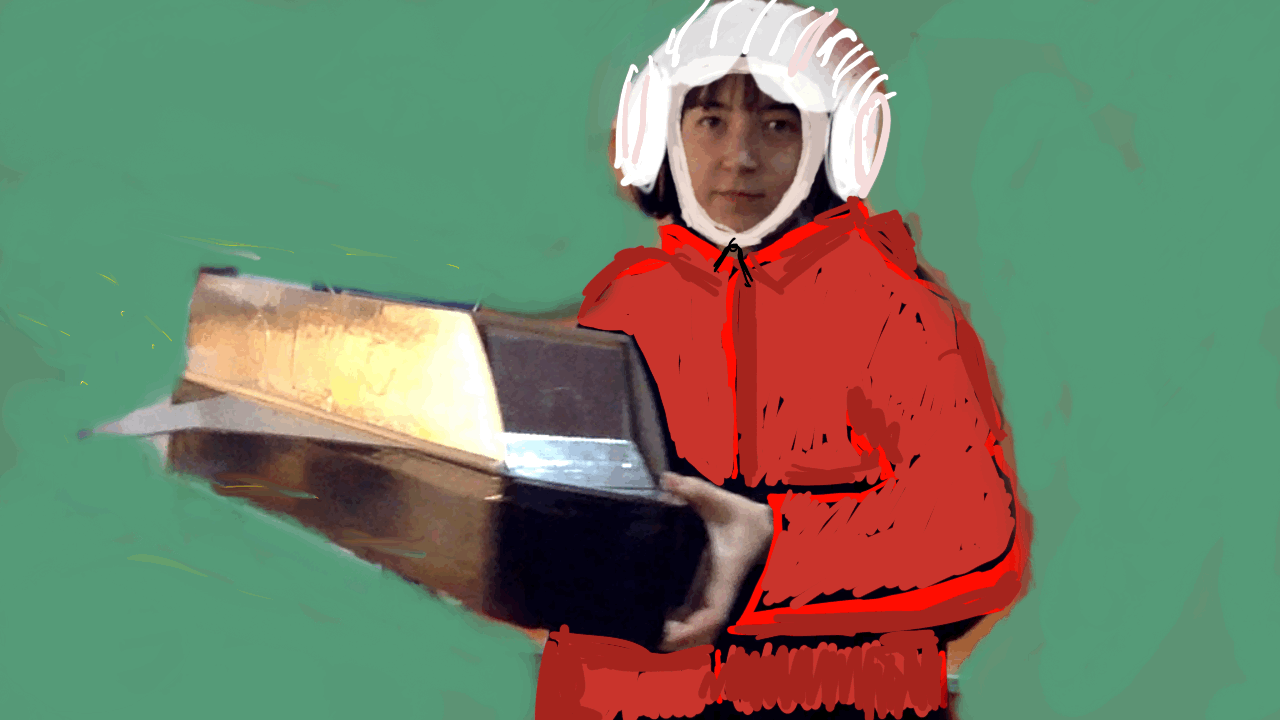
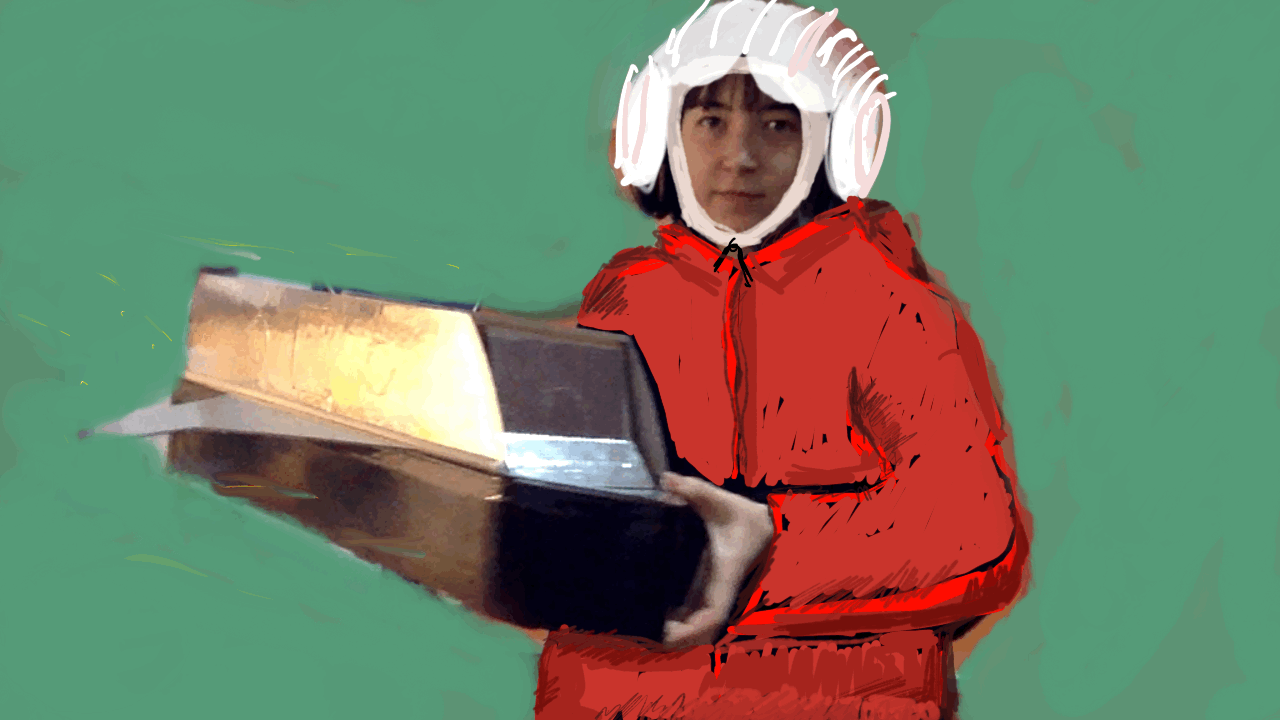
Addressing my self
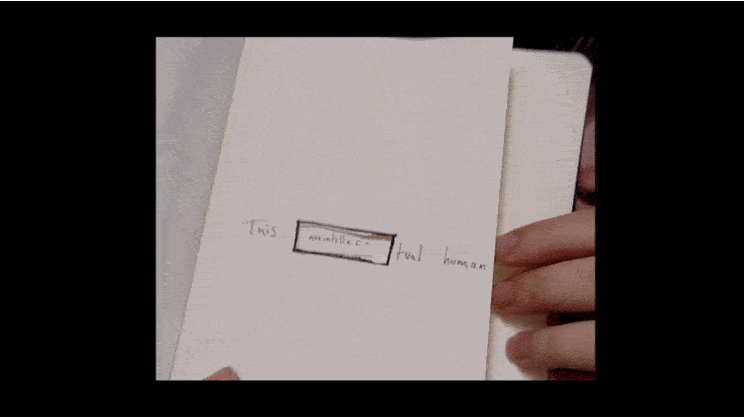
TUAL
TUAL
On a rather grainy news report from the 80s reporter runs around the local art scene of Sydney trying to get to the bottom of the group who call themselves alloa. by the reporter seems stunned by 'what's being called art these days, and is shocked a magazine article documents the winnings of this obscure artist group of £400,000 for an art piece whereby a curtain is soaked in blood. with his alarmingly large shoulder pads he takes us on a journey town where he tracks down the creator of the work Peter Hill. there's a rather funny scene of Hill running away from the reporter he's being accused of a crime.
when being asked about whether he made the work, he answers.
' yes I am my name is Peter Hill I teach here at the centre for the Arts in Hobart and it's part of a much bigger Project almost like a hoax museum of ideas'
' isn't this a con?'
' no for me it is an artwork and that artwork itself reflects both the serious and the absurd side of the contemporary art world'
Peter Hill didn't only master the job of creating a hoax of one art piece, in particular, represented a whole fictitious institution called the contemporary centre for ideas. the news report shows Peter Hill giving lectures about this institution to an audience filled with frowning faces confused looks. the idea may only live on paper but exists in so much detail in his mind. when a publication he made about the fictitious group got into the hands of a serious art critic, it leads to the fake institution being talked about and discussed in other lectures around world. it throws into question the validity of things that we might hear about ourselves or discover. it suggests something of the world that it is not so makes us contemplate what our reality really is. this institution was believed, believe to be important, so much so that people went to visit this fake place. got me thinking about the decisions make day today. when an idea goes beyond the boundaries of our mind it enters the world of choas and restriction. what's so different a fake art gallery real one? reminded me of a story I had not long ago a series of the podcast the 'fake heiress'. it follows the story of a young girl From Russia to make her way the New York scene. tending to be a wealthy individual, she works her way up the social ladder gaining popularity and trust. hair ambition is to create a real institution in New York a centre for the Arts. she finds a building to make her dreams come true. she gets loans from banks and companies. he interests the help of PR companies, photographers, artists, the list goes on. without a dime to her name she slowly gets found out. the world crumbles around her, and eventually, she gets thrown in jail. perhaps this is the Direct opposite of what Peter hell is trying to achieve. instead of living in the real world and creating a fictitious reality, the fake heiress does the opposite. the feeling of being disillusion for so long, is a Sensation that perhaps I want to accentuate throughout my films.
'The more ridiculous my ideas that I have are the more likely these ideas seem to happen in real life'
says Peter Hill he walks to play the reporter of his fake that he has made over his journey to fool us all.
I read one of Peter's Hills book's called 'Stargazing: Memoirs of a Young Lighthouse Keeper'. he talks of his first full-time job pursuing one of his childhood dreams of becoming a lighthouse keeper. whilst in Art School at the time he left the institution to pursue his dream before studying time was up. in the book books about how being a lighthouse keeper was crucially about your storytelling abilities were. working on shift, three people with live in the Lighthouse. isolated from the outside world, one part of the job was to keep of the people who were employed in the Lighthouse entertained. whilst one of the workers would sleep, the other would stay alert. this left one of the Lighthouse keepers job to make sure the one shift wouldn't fall asleep. and to do so they would tell stories to each other. Now, Lighthouse keeping would employ individuals for several months at a time. without having the opportunity to exist anywhere else but the confines of the tower, stories would have to be made up, more elaborate as the time went on.
This story has always stayed with me, perhaps because it encapsulates no effect of Chaos. And throughout my time in Art School, I think it lates how my experience has been pretty well. An idea tumbles into a reality which shifts the idea into something that was never originally planned. I think this is why I talk about functional failure so often. it predicts the failures of my work, so I don't need to be consistently explaining them.
Super fictions, Peter Hill's storytelling and deception





Sources:
Hill, Peter. “Superfictions —.” Superfictions.Org, https://www.superfictions.org/videos. Accessed 14 Apr. 2021.
The Hermann Nitsch Shower Curtain Video. www.youtube.com, https://www.youtube.com/watch?v=3iKpE1YQNJM. Accessed 14 Apr. 2021.
Hill, Peter. Stargazing: Memoirs of a Young Lighthouse Keeper. 2012.
Hill, Peter. “Superfictions and Adventurism - The Art in Everyday Life.” Artlink, vol. 4, no. 36, Dec. 2016, pp. 34–41.
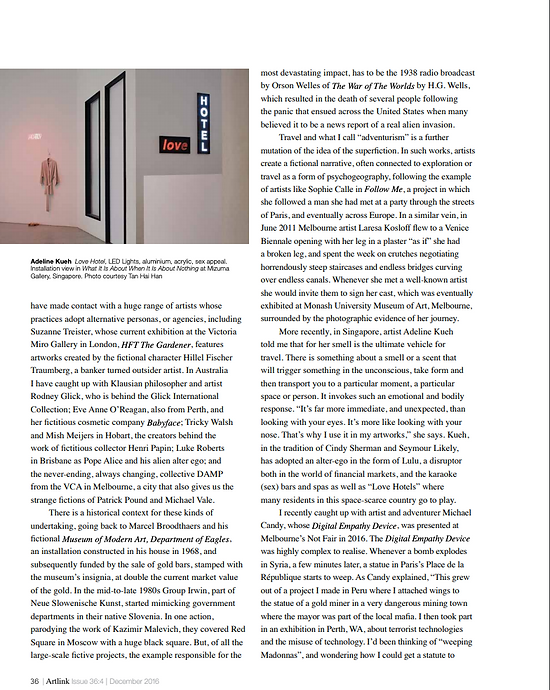



When questioning the validity of things, Peter Hill asks:
"How do we read the visual data including works of art and what happens when fiction escapes the pages of a novel and illusion slips out of the frame of the painting?"
Sourced: Hill, Peter. Peter Hill - True Lies and Superfictions. https://www.youtube.com/watch?v=XvHu5MT0N0I. AA School of Architecture.